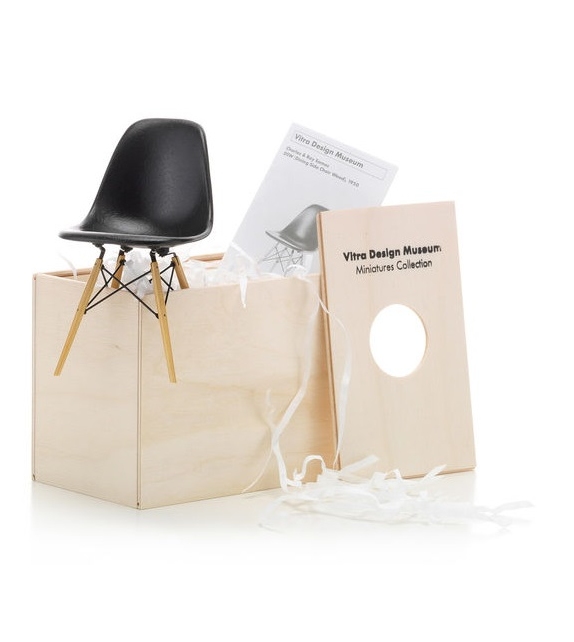The perfect time to take home the design objects you've always wanted. Enjoy our XMAS GIFTS now!
Miniature DSW Vitra, Eames
202 110 05
New product
Vitra Miniature DSW, Eames: For the first time in the history of design, Charles and Ray Eames utilized malleability of plastic forthe development of a comfortable seating shell that corresponds to the shape of the human body. The idea of making a three-dimensional molded shell goes back to a design from 1940.
Vitra Miniature DSW, Eames: The Fiberglass Chairs are rare examples of a satisfying synthesis of formal and technical innovation. For the first time in the history of design, Charles and Ray Eames utilized malleability of plastic forthe development of a comfortable seating shell that corresponds to the shape of the human body. The idea of making a three-dimensional molded shell goes back to a design from 1940. The original attempt to make the shell out of plywood was unsuccessful, however, due to the extreme conditions necessary to mold the material. Only with the advent of fiberglass technology was it possible to achieve satisfying results. The first Fiberglass Chair went into production in 1950. After years of experimentation, Charles and Ray Eames were able to realize their goal: an industrially produced chair that is inexpensive, sturdy, and comfortable. For ecological reasons however fibreglass was questionably. Thanks to recent advances in technology and materials, the DSW can be produced today in exact the same shape but made of polypropylene. Plastic shell, wooden/wire base.
The collection of the Vitra Design Museum en miniature: The Miniatures Collection of the Vitra Design Museum covers the most important pieces from the international history of design from 1850 up to the present. The construction, materials and colours of the miniatures correspond precisely to the historical original. Extensive development work was carried out to adapt the manufacturing techniques to the requirements of miniaturization. Because they are so true to the originals, the miniatures are not only collector’s objects for furniture enthusiasts, but also serve as ideal illustrative material for universities and design schools. At present, the collection encompasses 80 models on a 1:6 scale with further pieces being continually added. The models come in their own wooden box and are accompanied by a descriptive brochure with details on the design. Net proceeds from the sale of the miniatures go towards the exhibitions and workshops of Vitra Design Museum.
Miniaturization means concentration: Vitra Design Museum faithfully replicates furniture design classics in miniaturized three-dimensional form. Many of these designs, like the chaise longue by Le Corbusier or the red-blue chair by Gerrit Rietveld, are as widely known today as the most celebrated works of art and are coveted by museums and collectors the world over. These miniatures illustrate at a glance what design means and what role it plays in the industrial production process. The clear and concentrated world of the miniatures yields a fascinating reflection of the stylistic diversity of contemporary design and provides a unique way of accessing the history of furniture design.
The manufacture of the miniatures: Vitra Design Museum has one of the most renowned collections of industrial furniture design – from the infancy of industrial mass production in the mid-19th century through the designs of functionalistic Modernism up to the postmodern furniture objects of the present day. With its many exhibits, the collection provides us with an ideal base for developing new furniture miniatures. Model builders measure the historical original in the museum collection, scale this down to one sixth of the original size and compile technical documentation. Subsequently, materials and manufacturing techniques are tested over a period of several months: the shapes are formed, materials and processes are selected, art historical research on the objects is conducted and then the production sequences are defined.
100% Original
All the products from Miliashop are original and they are covered by warranty.
| Typology | Collectible items |
| Length | 8 cm |
| Width | 8.5 cm |
| Height | 13.5 cm |
| Design Year | 1820 - 2011 |
| Designer | Vitra Design Museum |





